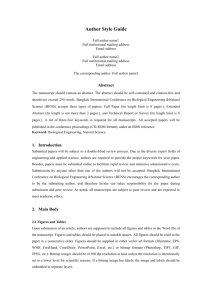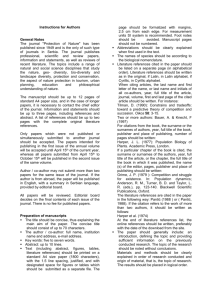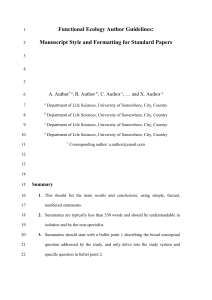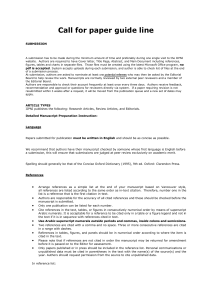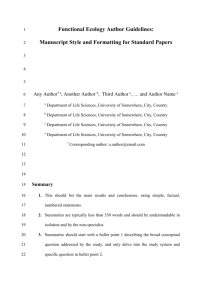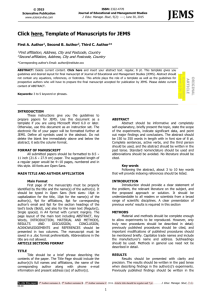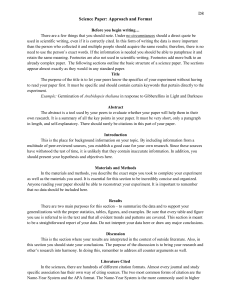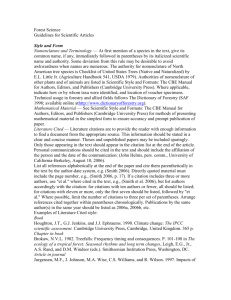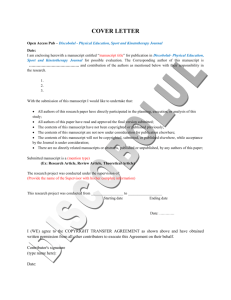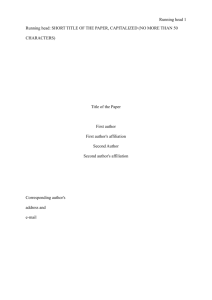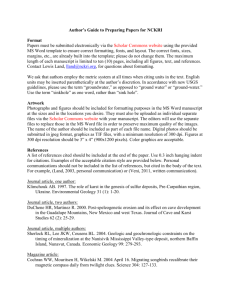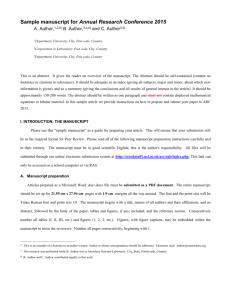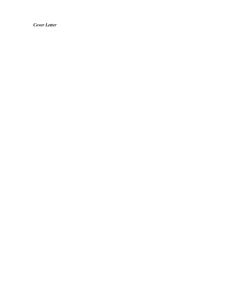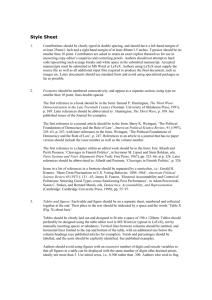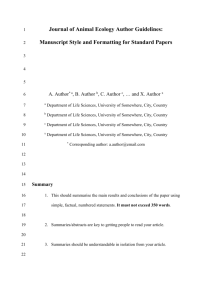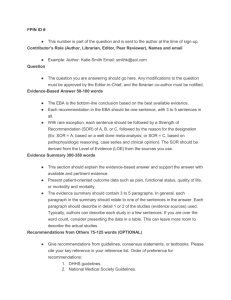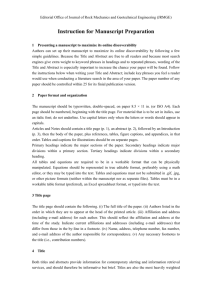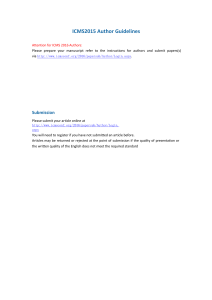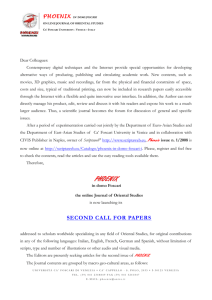(AUTHOR INSTRUCTIONS) Manuscripts Manuscripts should be
advertisement
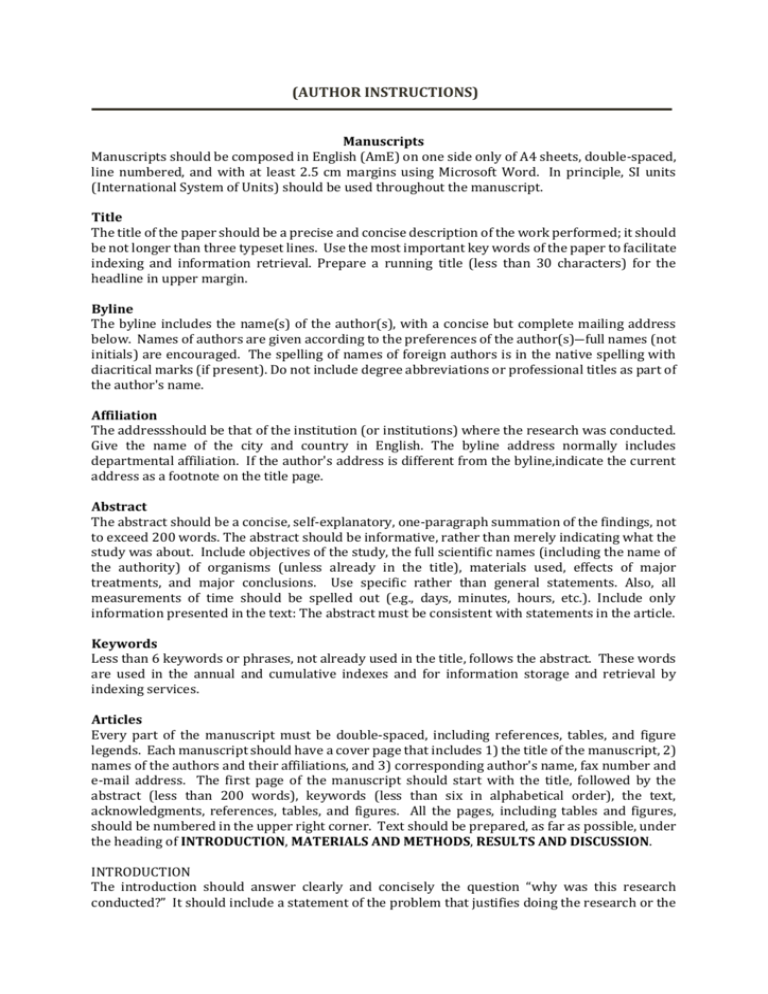
(AUTHOR INSTRUCTIONS) Manuscripts Manuscripts should be composed in English (AmE) on one side only of A4 sheets, double-spaced, line numbered, and with at least 2.5 cm margins using Microsoft Word. In principle, SI units (International System of Units) should be used throughout the manuscript. Title The title of the paper should be a precise and concise description of the work performed; it should be not longer than three typeset lines. Use the most important key words of the paper to facilitate indexing and information retrieval. Prepare a running title (less than 30 characters) for the headline in upper margin. Byline The byline includes the name(s) of the author(s), with a concise but complete mailing address below. Names of authors are given according to the preferences of the author(s)―full names (not initials) are encouraged. The spelling of names of foreign authors is in the native spelling with diacritical marks (if present). Do not include degree abbreviations or professional titles as part of the author's name. Affiliation The addressshould be that of the institution (or institutions) where the research was conducted. Give the name of the city and country in English. The byline address normally includes departmental affiliation. If the author's address is different from the byline,indicate the current address as a footnote on the title page. Abstract The abstract should be a concise, self-explanatory, one-paragraph summation of the findings, not to exceed 200 words. The abstract should be informative, rather than merely indicating what the study was about. Include objectives of the study, the full scientific names (including the name of the authority) of organisms (unless already in the title), materials used, effects of major treatments, and major conclusions. Use specific rather than general statements. Also, all measurements of time should be spelled out (e.g., days, minutes, hours, etc.). Include only information presented in the text: The abstract must be consistent with statements in the article. Keywords Less than 6 keywords or phrases, not already used in the title, follows the abstract. These words are used in the annual and cumulative indexes and for information storage and retrieval by indexing services. Articles Every part of the manuscript must be double-spaced, including references, tables, and figure legends. Each manuscript should have a cover page that includes 1) the title of the manuscript, 2) names of the authors and their affiliations, and 3) corresponding author's name, fax number and e-mail address. The first page of the manuscript should start with the title, followed by the abstract (less than 200 words), keywords (less than six in alphabetical order), the text, acknowledgments, references, tables, and figures. All the pages, including tables and figures, should be numbered in the upper right corner. Text should be prepared, as far as possible, under the heading of INTRODUCTION, MATERIALS AND METHODS, RESULTS AND DISCUSSION. INTRODUCTION The introduction should answer clearly and concisely the question “why was this research conducted?” It should include a statement of the problem that justifies doing the research or the hypothesis on which it is based, the findings of (and reference to) earlier work (if applicable) that will be challenged or developed, and the general approach and objectives. MATERIALS AND METHODS The technical and experimental methods must be described so that the work may be replicable. For materials, give the appropriate technical specifications and quantities and source or method of preparation. Give enough information to indicate how the research was conducted. Wellknown tests or procedures should be cited but not described in detail. Describe any controls and the statistical procedures. Method papers should be detailed enough to permit replication of the work. When specific equipment is mentioned in the text, include the model number followed by the name and location (model; city, state, country) of the manufacturer in parentheses. RESULTS AND DISCUSSION Present results succinctly in a format consistent with experimental design, with emphasis on main effects and significant interactions. The text and tables should discuss the topics in the same sequence. All figures and tables must be cited in numeric order in the text. Interpret results in the discussion. Report and discuss only those resultsthat are relevant to the study. The discussion should compare and explain any differences in the results within the experiment or those contrary to previous studies. Discuss any practical applications of the study and areas for future research. Speculation is encouraged, but must be firmly founded in observation and subjected to tests, and identified apart from the discussion and conclusions. Close the discussion with a brief, pertinent conclusion or interpretive statement; complex conclusions should form a separate section but generally are not necessary if the information is included in the abstract. Avoid summaries indicating, “future work is necessary” or “further work is under way” because “previews of coming attractions” are unacceptable and will not be published by the journal. The section on “RESULTS” can be combined with the section on “DISCUSSION” or they can be separate. ACKNOWLEDGEMENTS Acknowledgements can be included after “DISCUSSION” in a separate paragraph if applicable without separate heading. REFERENCES The reference section should include only published, significant, and relevant sources accessible through a library or an information system. These include journal articles, books, theses, dissertations, proceedings, bulletins, reports, and published abstracts of papers presented at meetings. Unpublished work, privileged data, or information received personally should be noted parenthetically in the text. Cite all references in the text by last names and year of publication. Text citations should be arranged from the earliest to most recent year, alphabetized by name within the same year. If authors and the year are the same in the cited references, lower-case alphabet letters should be attached to the year, such as 1990a and 1990b, so that the reference can be readily distinguished. When the number of authors are two in a cited reference, cite the reference with both author's name with ‘and,’ e.g., (Toyota and Hitachi, 1987). When the number of authors are more than three in acited reference, cite the reference with the first author with ‘et al.’ as long as ambiguity is avoided. For entries in REFERENCES, alphabetize by authors' last names and follow the styles below exactly for capitalization, punctuation, and order of elements. Journal article; Author, A. B., Author, B. B. 2002. Title of article. Name of Journal. 43: 35‐45. Book article; Author, A. B., Author, B. B., Author, C. C. 2003. Title of article. In “Title of Book”(ed. by Author, D. D., Author, E. E.), Ed. 2, Vol. 3. Publisher, City, p 15‐25. Book; Author, A. B., Author, B. C. 2003. Title of Book. Publisher, City, pp 565. Thesis; Author, B. C. 2003. Title of thesis. PhD thesis. University, City, pp 204. Abstract; Author, A. B., Author, B. B. 2003. Title of abstract. (abstract No. xx), Name of Academic Meeting, Month, City, Name of Journal (abstract) p 135. No authors or editors; Title of Booklet, Pamphlet, etc. 2004. Publisher (or Company), City, pp 23. Tables Tables should document but not duplicate data already given in the text. Keep the number of tables to a minimum. Start each table (with all parts double-spaced) on a separate page and number each table with Arabic numerals (e.g., Table 1, Table 2,etc.). Place tables after REFERENCES. The title, column and row headings, and footnotes of each table should be selfexplanatory. Capitalize only the first letter of the first word of each column and row heading. To identify tabular footnotes, use lowercase letters starting from the end of the alphabet (sequence z, y, x...). If letters or symbols are used to indicate statistical significance at different levels, use (with explanatory footnotes) either lowercase letters from the beginning of the alphabet (a, b, c...) or a single asterisk (*) for P≤0.05, either uppercase letters from the beginning of the alphabet (A, B, C...) or a double asterisk (**) for P≤0.01, and a triple asterisk (***) for P≤0.001. Figures Illustrations are often the best means for presenting scientific data, revealing trends, or recording natural appearance. Data presented in tables should not be duplicated in figures. Identify all graphs, line drawings, and photographs with consecutive Arabic numerals (e.g., Fig. 1, 2, or 3). Number the figures in the sequence in which they are cited in the text. All figures must be cited. Information in captions should be clear and concise and understood independently from the text (all acronyms and abbreviations should be spelled out as in the text). Symbols used in graphs and charts should be keyed. If symbols are necessary for reference in the text, then choose standard symbols, such as the triangle, box, or circle. Complex symbols do not translate from disks and cannot be replicated easily.

